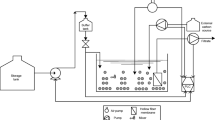Abstract
In this research the effect of silicone oil as a heavy organic solvent on the performance of a mixed tank bioreactor was investigated. In the first stage of the experiments, the response of a two-liquid-phase mixed tank bioreactor to periods of n-hexane starvation was compared with that of a control bioreactor. In the control bioreactor, after 3 days of starvation, approximately six days were needed to reach the removal efficiency it had before starvation. This figure was only 10 h for the silicone oil-containing bioreactor. The results confirmed that inclusion of a heavy organic solvent can increase the elimination capacity of a bioreactor and to help sustain high elimination capacity after starvation periods. In the second stage of the experiments, the effect of the amount of silicone oil on the performance of the bioreactor was investigated. Increasing the amount of oil from 5 to 10% (v/v) increased the maximum elimination capacity from 106 to 117 g/m3 h.





Similar content being viewed by others
References
Z. Shareefdeen, A. Singh, Biotechnology for Odor and Air Pollution Control, 1st edn. (Springer, Berlin, 2005), p. 29
R. Munoz, S. Villaverde, B. Guieysse, S. Revah, Two-phase partitioning bioreactors for treatment of volatile organic compounds. Biotechnol. Adv. 25, 410 (2007)
A.B. Neal, R.C. Loehr, Use of biofilters and suspended-growth reactors to treat VOCs. Waste Manage. 20, 59 (2000)
J.V. Littlejohns, A.J. Daugulis, A two-phase partitioning airlift bioreactor for the treatment of BTEX contaminated gases. Biotechnol. Bioeng. 103(6), 1077 (2009)
S. Arriaga, R. Munoz, S. Hernaandez, B. Guieysse, S. Revah, Gaseous hexane biodegradation by Fusarium solani in two liquid phase packed-bed and stirred-tank bioreactors. Environ. Sci. Technol. 40, 2390 (2006)
F. Lalanne, L. Malhautier, J.-C. Roux, J.-L. Fanlo, Absorption of a mixture of volatile organic compounds (VOCs) in aqueous solutions of soluble cutting oil. Bioresour. Technol. 10, 1 (2007)
M.H. Fazaelipoor, S.A. Shojaosadati, The effect of silicone oil on biofiltration of hydrophobic compounds. Environ. Prog. 21, 4 (2002)
S.F. Hashemi, A.S. Goharrizi, M.H. Fazaelipoor, Two liquid-phase bubble column bioreactors for the removal of volatile organic compounds from air streams. Asia-Pac. J. Chem. Eng. (2011). doi:10.1002/apj.591
Author information
Authors and Affiliations
Corresponding author
Rights and permissions
About this article
Cite this article
Booshehri, A.Y., Goharrizi, A.S. & Fazaelipoor, M.H. The effect of starvation periods on the performance of a two-liquid-phase mixed tank bioreactor for removal of n-hexane from air streams. Res Chem Intermed 38, 1021–1028 (2012). https://doi.org/10.1007/s11164-011-0438-0
Received:
Accepted:
Published:
Issue Date:
DOI: https://doi.org/10.1007/s11164-011-0438-0




